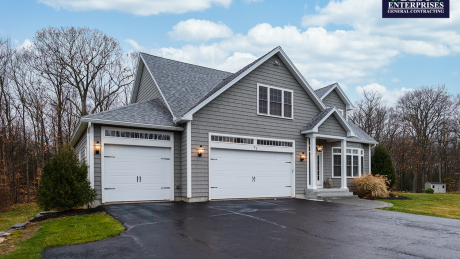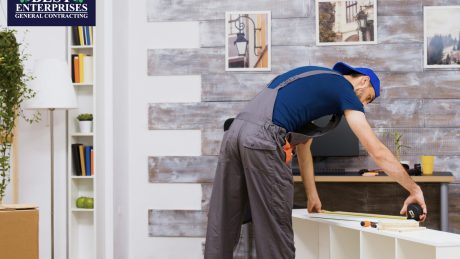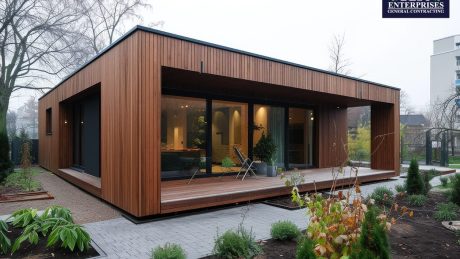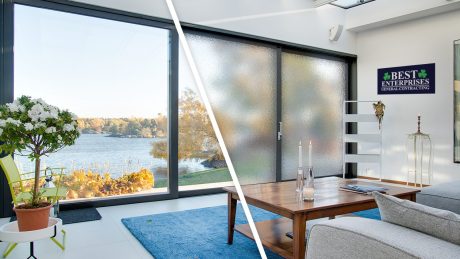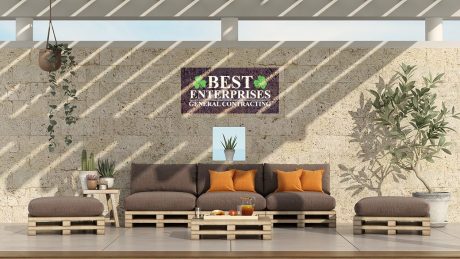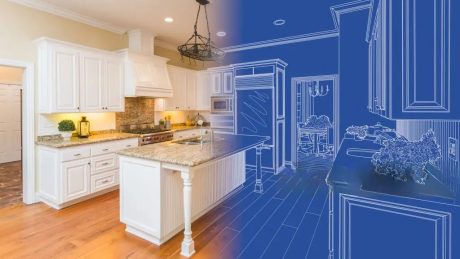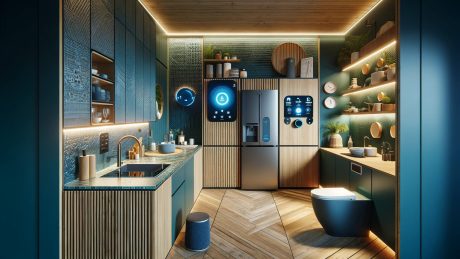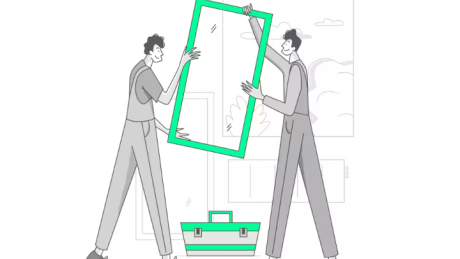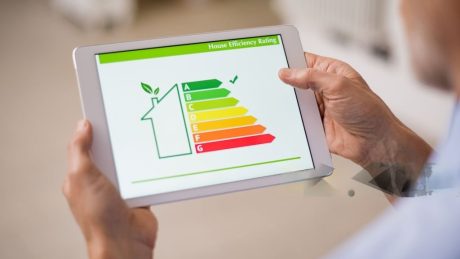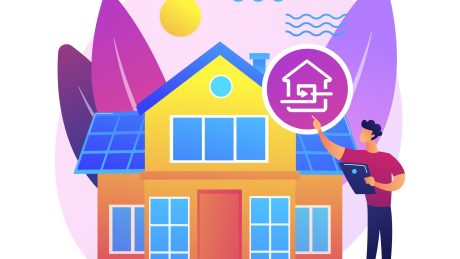Choosing Siding Materials: Pros, Cons, and Costs
Choosing the right siding materials is crucial for protecting and beautifying your home. This blog will help you navigate various options, considering energy efficiency, cost-effectiveness, and eco-friendliness.
Vinyl Siding: Affordable and Low-Maintenance
Considering affordability and low maintenance requirements, vinyl siding is considered one of the most popular choices for homeowners.
Pros:
- Cost-effective: Generally priced between $7.50 to $9.50 per square foot
- Low maintenance: Requires only occasional cleaning
- A variety of colors and styles are available
- Durable: Can last for may years with periodic maintenance.
Cons:
- Limited insulation properties in standard versions
- Can warp in extreme heat or become brittle in severe cold
- Not the most eco-friendly option due to its plastic composition
Energy Efficiency:
While standard vinyl siding offers limited insulation, insulated vinyl siding is available. This option can significantly improve your home’s energy efficiency, potentially lowering heating and cooling costs.
Fiber Cement Siding: Durability Meets Versatility
Fiber cement siding is widely popular for its durability and versatility in mimicking other materials.
Pros:
- Highly durable and long-lasting
- Fire-resistant and pest-resistant
- Available in wooden or other materials finish.
- Low maintenance requirements
Cons:
- More expensive than vinyl, typically costing $10 to $14 per square foot
- Heavier than some alternatives, which can increase installation costs
Eco-Friendly Aspect:
Fiber cement is made from sustainable materials and is long-lasting, reducing the need for frequent replacements.
Wood Siding: Natural Beauty with a Caveat
Wood siding offers a timeless, natural look but needs specific maintenance.
Pros:
- Natural, aesthetically pleasing appearance
- Allows painting and stained look to suit preferences
- When sourced responsibly, it’s a renewable resource
Cons:
- Relatively high in maintenance to prevent rot and pest infestation
- More expensive than vinyl, ranging from $8 to $12 per square foot
- Shorter lifespan compared to some alternatives (20-40 years)
Eco-Friendly Options:
Look for FSC-certified wood to ensure it comes from sustainably managed forests. Reclaimed wood siding is another excellent eco-friendly option, offering unique character and reducing demand for new timber.
Metal Siding: Durability and Energy Efficiency
Metal siding, including aluminum and steel, offers excellent durability and can be an energy-efficient choice.
Pros:
- Highly durable and long-lasting (40-60 years for steel)
- Low maintenance requirements
- Fire-resistant and pest-resistant
- Can reflect heat, improving energy efficiency
Cons:
- Expensive compared to vinyl or fiber cement
- Prone to denting, especially aluminum
- May amplify outside noise
Energy Efficiency:
Metal siding, particularly when properly insulated, contributes to your home’s energy efficiency by reducing heat in summer and retaining warmth in winter.
Cost Comparison and ROI
When considering siding options, it’s essential to look beyond the initial cost and consider the long-term return on investment (ROI):
- Vinyl Siding: Offers approximately 80% ROI
- Fiber Cement: Provides around 77% ROI
- Wood Siding: Also offers about 77% ROI
- Metal Siding: ROI varies but can be similar to fiber cement
Remember, while initial costs are important, factors like durability, maintenance requirements, and energy efficiency play crucial roles in the overall value of your siding choice.
Conclusion
The best siding material for your home depends on your needs, budget, and priorities. When deciding, consider factors like local climate, desired aesthetics, maintenance willingness, and long-term costs. Choosing the right siding material involves balancing cost, durability, maintenance, and aesthetic appeal. By considering the pros and cons of each option and understanding their impact on your home’s ROI, you can make an informed decision that enhances your home’s value and curb appeal. Ready to transform your home’s exterior? Contact us today to schedule a consultation and start your siding project!
Pros and Cons of DIY Home Renovation: What Every Homeowner Should Know
Introduction to DIY Home Renovation
DIY home renovation projects may be very fulfilling and cost-effective, giving you a sense of accomplishment. They do, however, also present a unique set of difficulties. Make sure you carefully consider the benefits and drawbacks before taking on a renovation job yourself. This guide will enable you to decide if DIY home renovations are the correct choice.
Pros of DIY Home Renovation
Cost Savings
The possibility of cost savings is one of the most alluring features of DIY home remodeling. Homeowners can stretch their budgets further and devote money to other project components by doing away with labor expenses. A do-it-yourself makeover typically costs $10,000, while hiring a professional costs between $30,000 and $100,000.
Flexibility and Control
With DIY projects, you may set your hours and make decisions without seeking advice from others. This adaptability may be especially helpful if you lead a busy life and must schedule the renovation around other obligations.
Creative Freedom
Taking up a DIY project allows you to try new things and realize your ideas without constraints. The materials, finishes, and design components that most closely match your preferences can be chosen.
Sense of Accomplishment
Finishing a DIY project can bring a special sense of fulfillment and pride. Seeing your vision come to life and knowing that you created it all yourself can be tremendously satisfying.
Cons of DIY Home Renovation
Time-Consuming
DIY projects often take longer than anticipated, especially if you are learning new skills as you go. On average, a DIY home renovation could take around 16 hours a week, stretched over 5 or 6 weeks. If you have other commitments, this timeline could be even longer.
Limited Skillset
Not all homeowners have the skills required to complete a renovation project to a high standard. Tasks such as electrical work, plumbing, or structural changes demand expertise that not all homeowners possess. Mistakes can lead to costly repairs and potentially dangerous situations.
Hidden Costs
While DIY projects can save money upfront, there are often hidden costs associated with them. You may need to purchase tools and equipment that a professional already has. Mistakes or unexpected challenges may necessitate additional purchases and repairs, quickly escalating the overall project cost.
Quality and Safety Concerns
Without professional training, there is a significant risk of subpar results that compromise the longevity and functionality of the renovation. Additionally, DIY projects can pose safety risks, such as exposure to hazardous materials or the potential for injury during the renovation process.
Tips for Successful DIY Home Renovation
Planning and Budgeting
Thorough planning and realistic budgeting are crucial for a successful DIY renovation. Make sure to account for all potential costs, including tools, materials, and any unexpected expenses that may arise.
Learning and Preparation
Take the time to learn the necessary skills and prepare for the project. Utilize resources such as YouTube tutorials, online courses, and DIY guides to build your knowledge and confidence.
Knowing When to Hire a Professional
Recognize the limits of your skills and know when it’s best to hire a professional. For complex tasks such as electrical work, plumbing, or structural changes, bringing in an expert is often safer and more cost-effective.
Conclusion: DIY Home Renovation
DIY home can be a terrific way to save money and feel proud. However, they also provide several difficulties, such as the need for competence, time commitment, and possible hidden expenses. You may determine whether DIY home renovation is right for you by carefully considering the pros and cons and making a detailed strategy. If you choose to take on a project, go cautiously and be ready to hire an expert when necessary.
Are you considering a home renovation but need clarification on whether DIY is the right choice? Contact our expert team for professional advice and services to ensure your project’s success!
- Published in Uncategorized
Best Insulated Siding for Long Island Homes: A Guide
Introduction
Choosing the right insulated siding is crucial for enhancing your Long Island homes energy efficiency and aesthetic appeal. Insulated siding, particularly insulated vinyl siding, offers numerous benefits, making it an excellent choice for homeowners to install siding in this region. This guide will help you understand the advantages of insulated siding and how to choose the best option for your home.
Understanding Insulated Siding
Insulated siding is a type of exterior cladding that includes a layer of insulation, typically made from expanded polystyrene foam (EPS), adhered to the back of the siding material. This design enhances the siding’s thermal and acoustic insulation properties, making it more effective at maintaining indoor temperatures and reducing noise pollution.
Benefits of Insulated Siding for Long Island Homes
Energy Efficiency
One of the standout benefits of insulated vinyl siding is its ability to improve your home’s energy efficiency. Insulated siding helps prevent thermal transfer, reducing heat loss in the winter and heat gain in the summer. This means your HVAC system can work less hard, leading to lower energy bills. Insulated vinyl siding typically boasts R-values between R-2 and R-4, significantly enhancing thermal efficiency compared to non-insulated options.
Durability
Long Island’s coastal weather can be harsh, with salty sea breezes, storm-driven rains, and fluctuating temperatures. Insulated vinyl siding is designed to withstand these conditions, resisting moisture, rot, warping, and corrosion. It also performs well in cold and hot weather, ensuring your home looks great and remains protected for years.
Noise Reduction
Living near busy streets or densely populated areas can bring unwanted noise into your home. Insulated siding acts as a sound barrier, keeping much of the outdoor noise where it belongs—outside. This can significantly improve the comfort and tranquility of your living space.
Low Maintenance
Compared to other siding materials, insulated vinyl siding requires remarkably low upkeep. It does not need painting or staining—only occasional cleaning with mild soap and water. This low-maintenance aspect is a big sell for anyone who wants to keep their home looking great with minimal effort.
Top Insulated Siding Options
Insulated Vinyl Siding
Insulated vinyl siding is a popular choice due to its excellent balance of cost, durability, and energy efficiency. It comes in various colors and styles, allowing homeowners to achieve the desired look for their homes while benefiting from enhanced insulation.
Fiber Cement Siding
Fiber cement siding is another durable option that offers good insulation properties. It is resistant to weather, pests, and fire, making it a reliable choice for Long Island homes. However, it is generally more expensive and requires professional installation.
Engineered Wood Siding
Engineered wood siding combines the aesthetic appeal of natural wood with enhanced durability and insulation. It is designed to withstand harsh weather conditions and is less prone to rot and insect damage than traditional wood siding.
Cost Considerations
While insulated siding can be more expensive upfront than non-insulated options, the long-term savings on energy bills and reduced maintenance costs can make it a cost-effective choice. The improved energy efficiency and durability can increase your home’s value, providing a good return on investment.
Installation Tips
Proper installation is crucial to achieving the full benefits of insulated siding. Hiring a professional contractor with experience installing insulated siding is recommended to ensure the job is done correctly. Look for contractors with good reviews and ask for references to ensure you are hiring a reliable professional.
Ready to upgrade your home with insulated siding? Visit our Siding page to learn why you should Choose us for service options and to hear from experienced siding professionals!
Conclusion
Insulated siding offers numerous benefits for Long Island homeowners, from improved energy efficiency and durability to noise reduction and low maintenance. Choosing the right insulated siding type and ensuring proper installation can enhance your home’s comfort, appearance, and value. Consider insulated vinyl siding for its excellent cost and performance balance, and enjoy its long-term benefits.
Be sure to improve your home’s energy efficiency and curb appeal. Contact us now to learn more about our insulated siding options and schedule your installation!
Smart Glass Windows: Revolutionizing Views and Energy Efficiency
Introduction
Windows have transcended their traditional roles of providing light and ventilation. Today, they are at the forefront of technological innovation, enhancing both aesthetics and functionality. One of the most groundbreaking advancements in this domain is smart glass technology. This blog delves into the world of smart glass, exploring its workings, benefits, applications, and the transformative impact it has on modern homes.
Traditional windows, long valued for providing light and views, are now being revolutionized by smart glass technology. This cutting-edge innovation is set to transform how we see the world from our homes and manage energy efficiency and comfort within them.
What is Smart Glass?
Smart glass is a dynamic glazing technology that allows windows to change their light transmission properties when voltage, light, or heat is applied. This transformation can be controlled manually, automatically, or through a smart home system, providing unparalleled flexibility and efficiency. Smart glass technology is often associated with Energy Star windows due to its significant energy-saving potential.
Types of Smart Glass:
- Electrochromic Glass: Changes color or opacity in response to an electrical current. This type of smart glass changes its tint when an electrical voltage is applied. It offers precise control over light and heat entering a space, making it ideal for energy-efficient homes. The price of electrochromic glass can vary, but it is generally higher due to its advanced technology. It’s popular for its controllability and precision.
- Thermochromic Glass: This glass changes its tint in response to temperature changes. It is a passive technology that does not require electrical power, making it a cost-effective option for certain applications.
- Photochromic Glass: Similar to transition lenses, this glass darkens in response to sunlight. It is particularly useful for reducing glare and UV exposure.
These technologies collectively contribute to the growing popularity of energy-efficient windows, such as Energy Star windows, which help reduce energy consumption and enhance indoor comfort.
Benefits of Smart Glass
Energy Efficiency and Cost Savings
One key advantage of smart glass is its ability to improve energy efficiency. By optimizing natural light and heat, smart glass significantly reduces the need for artificial lighting and air conditioning. This leads to substantial energy savings and lower utility bills, aligning with the principles of Energy Star windows.
Improved Comfort
Smart glass enhances indoor comfort by reducing UV exposure and glare. It maintains a consistent indoor temperature, creating a more pleasant living environment. Additionally, by minimizing glare it ensures that you can enjoy natural light without the drawbacks.
Enhanced Privacy
Smart glass offers privacy on demand. Smart glass can switch from transparent to opaque, providing privacy without curtains or blinds. This feature is particularly beneficial for bathrooms, bedrooms, and street-facing windows.
Applications of Smart Glass
Residential
In homes, smart glass is used in windows, skylights, and doors. It allows homeowners to control their environment, enhancing comfort and energy efficiency.
Commercial
In commercial settings, smart glass is utilized in office buildings, storefronts, and conference rooms. Its ability to create adaptable work environments and impressive displays makes it an attractive option for businesses looking to enhance aesthetics and functionality. It provides privacy on demand and contributes to a modern, sleek aesthetic.
Installation and Maintenance
Installation Process
The installation of smart glass involves several steps, including measuring, cutting, and fitting the glass panels. It is crucial to work with experienced professionals to ensure proper installation and integration with existing systems.
Maintenance Tips
Smart glass requires minimal maintenance. Regular cleaning with non-abrasive materials and periodic checks of the electrical components (for electrochromic glass) will ensure longevity and optimal performance.
Cost Analysis
Initial Investment vs. Long-term Savings
While the initial investment in smart glass can be higher than traditional windows, the long-term savings in energy costs and the potential increase in property value make it worthwhile. Reducing heating, cooling, and lighting expenses further enhances the return on investment (ROI).
Case Studies/Examples
Showcasing Best Enterprises Projects
Best Enterprises has successfully implemented smart windows in various residential projects, showcasing the technology’s transformative impact. Homeowners have reported significant improvements in energy efficiency and overall comfort. One notable project involved the installation of electrochromic windows in a modern home, resulting in a 30% reduction in energy costs and enhanced living comfort.
Testimonials
Homeowners and builders alike have praised the benefits of smart glass. One homeowner noted,
“The smart windows have reduced our energy bills and added a modern touch to our home. The ability to control privacy and light at the touch of a button is truly revolutionary.”
Conclusion
The future of home design is undoubtedly intertwined with smart glass technology. As this technology continues to evolve, it promises to bring even greater energy efficiency, comfort, and aesthetic appeal to homes. Embracing smart glass is not just a trend but a step towards a more sustainable and intelligent living environment.
Custom Deck Design: Tips and Trends for Your Outdoor Space
Introduction
Step outside into your beautifully extended living space that connects you deeply with the natural world. A custom deck design can turn any simple backyard into your stunning outdoor sanctuary, perfect for relaxation or entertainment.
As we explore the latest trends in deck design, homeowners today have a plethora of exciting options to transform their outdoor areas into personal havens. From integrated functionality to innovative materials, these trends are shaping the way we think about and utilize our outdoor spaces, making them more versatile and appealing than ever.
Understanding Your Space
To start, it’s crucial to carefully assess the space you have. Outdoor living space contractors often emphasize the importance of understanding the dimensions and potential of your area. This initial assessment is key to envisioning how you want to use the space—whether it’s for intimate family dinners or large gatherings with friends. Consider the landscape and surrounding environment, which can influence everything from sun exposure to wind patterns. These factors are essential in planning your deck’s functional and aesthetic aspects, guiding choices like including shade structures or privacy screens.
Current Trends in Deck Design
Today’s decks are far more than just wooden platforms. Homeowners are loving the integration of built-in seating, which not only saves space but also adds a touch of sophistication. Multi-level decks are particularly popular, offering distinct areas for different activities such as dining, lounging, or sunbathing. These designs can effectively utilize uneven yard landscapes, turning a potential challenge into a unique, eye-catching feature. The advantages of multi-level decks extend beyond aesthetics, as they can enhance the functionality of outdoor space by clearly defining activity zones and improving overall flow.
The choice of materials has also shifted towards sustainability, with eco-friendly deck materials becoming increasingly favored. Composite decking, made from recycled wood and plastic, is a popular choice for its durability and minimal maintenance requirements. Other sustainable options include bamboo and responsibly sourced wood, which offer both environmental benefits and natural beauty.
By embracing these current trends, you can ensure that your deck is not only visually appealing but also aligned with modern building practices that prioritize environmental consciousness and innovative design.
Design Elements to Consider
Choosing the right colors and textures is essential for blending your deck with your home’s exterior. A harmonious design can effortlessly enhance your home’s overall charm. When it comes to railings, you have a variety of materials at your disposal—from elegant glass to classic wood—that can define the look and feel of your deck. Effective lighting will ensure that your deck is inviting at all hours, and adding personal touches like cozy cushions and vibrant planters will make the space yours.
Functional Considerations
Durability is key in deck design. Opt for materials and construction techniques that stand up well to your local climate, minimizing wear and ensuring longevity. Safety is another critical aspect, particularly if you have children or elderly family members using the space. Incorporating safety features such as handrails, gates at stair entries, and slip-resistant surfaces can help prevent accidents and ensure a safe environment for everyone. Non-slip surfaces are particularly important in areas prone to wet weather, providing extra grip and peace of mind.
Features like sturdy railings and secure, easy-to-navigate steps are vital for a secure, worry-free environment. Ensuring that your deck is not only a beautiful addition to your home but also a safe one will allow you and your family to enjoy it with confidence for years to come.
Conclusion
At Best Enterprises, we pride ourselves on transforming spaces with unique, functional decks with the best decoration tips. One standout project was a conversion of a tight backyard into a sprawling, multi-level deck that segmented areas for dining, relaxation, and gardening, complete with sustainable materials and efficient use of lighting that accentuated the deck’s best features.
Delving into custom deck design can significantly boost both the functionality and aesthetic of your outdoor space. With the latest trends favoring customized, sustainable options, there’s no limit to how you can enhance your outdoor living experience. Engaging with experts like Best Enterprises ensures that your new deck will perfectly fit your home and lifestyle. Embark on transforming your outdoor space today—your personal outdoor retreat awaits!
Why Lifetime Warranties Give You Peace of Mind in Home Remodeling
Introduction:
A lifetime warranty represents more than a mere perk; it embodies a declaration of quality and commitment. Providers of these warranties promise to fix any defects or failures in products or workmanship without extra charges for the homeowner as long as they own the home. Such assurances are becoming more popular among homeowners who view them as protective measures for their investments and a way to secure peace of mind. Consequently, as consumers place more emphasis on long-term value and sustainability, they are increasingly attracted to the security and financial wisdom that lifetime warranties provide, thus making these warranties a favored option in home improvement decisions.
The Value of Lifetime Warranties:
Lifetime warranties protect against future expenses on repairs and replacements, implying that the products are built to last using high-quality materials and expert craftsmanship. When a company offers such a warranty, it showcases their confidence in the product’s durability. This assistance allows homeowners to save on unexpected costs and offers substantial psychological comfort. Knowing their investments are secured for the long term, homeowners can enjoy their renovations without concerns about future problems, thereby fostering a sense of security and trust in the provider.
Comparing Warranties:
Warranties vary significantly in scope and duration. Standard warranties typically cover home remodeling elements such as roofing, windows, and kitchen appliances for limited periods—usually ranging from 10 to 30 years, depending on the product.
In contrast, lifetime warranties offer coverage for the entire duration you own your home, ensuring indefinite protection against unforeseen issues. This can be especially valuable for major investments such as roofing or siding, where replacement and repair costs can be substantial.
Choosing lifetime warranties brings significant long-term advantages, such as peace of mind and potential savings on future repairs. Consequently, these warranties increase both the value and enjoyment of your home.
Case Studies:
Here are a few real-life case studies that illustrate the significant benefits of lifetime warranties for homeowners:
- Roofing Materials: One case involves roofing materials. Certain products, like pressure-treated pine, have warranties that can last up to 50 years; others, like white oak, can last up to 75 years. Such warranties ensure that homeowners are covered for the practical lifetime of their roofs, which are often a costly part of the home to replace. This long-term warranty protection protects homeowners from potential large-scale repair expenses decades after installation.
- Home Appliances and Products: Companies such as CamelBak and Calphalon provide lifetime warranties that cover defects in materials and workmanship. For example, CamelBak’s “Got Your Bak” guarantee promises replacements for its hydration packs if they fail because of manufacturing defects. Consequently, this type of company boosts customer confidence in the longevity and quality of their purchases.
Outdoor and Adventure Gear: Dakine provides a limited lifetime warranty on its backpacks and bags, emphasizing its commitment to durability and customer satisfaction. This warranty covers manufacturing defects, giving consumers peace of mind that they purchase gear built to last, even under rigorous conditions.
Choosing the Right Contractor:
When selecting contractors for home remodeling projects, choosing one that offers comprehensive lifetime warranties can significantly enhance your investment’s long-term value. Here are some tips on how to select the right contractor, questions to ask, and what to look out for in the fine print of warranty agreements:
Tips on Selecting Contractors
- Research Reputation: Look for contractors with a solid reputation for quality and reliability. Check online reviews testimonials, and ask for referrals from friends or family.
- Verify Credentials: Ensure the contractor is licensed, insured, and bonded. This protects you from liability and ensures they meet industry standards.
- Experience with Warrantied Work: Prefer contractors with a history of offering and honoring lifetime warranties. This indicates they stand behind their work with confidence.
How Contractors with Comprehensive Lifetime Warranties Can Help
Contractors who provide lifetime warranties often select higher-quality materials and adhere to best practices, aiming to minimize future warranty claims. Consequently, they tend to be more meticulous in their work, aware that they bear responsibility for any future issues. This dedication generally results in higher initial quality and reduces hassle.
Questions to Ask
- What does the warranty cover?
(Ask for specifics about what elements of the work are covered, such as materials, labor, or both.) - How long is the warranty valid, and is it transferable?
(This is crucial if you plan to sell your home.) - What is the process for filing a warranty claim?
(Understand how claims are handled, the typical response time, and any costs involved.)
What to Look for in the Fine Print
- Exclusions and Limitations: Look closely for what is not covered by the warranty. Common exclusions include damage from natural disasters or improper use of the product.
- Proration Terms: Some warranties lose value over time. Check whether the warranty offers full replacement or depreciates.
- Transferability: Verify whether the warranty is transferable to new owners, as this can be a selling point if you decide to move.
Selecting the right contractor who provides comprehensive lifetime warranties guarantees the durability and longevity of your remodeling project and gives you peace of mind, knowing that future issues are covered. Therefore, always make sure to thoroughly understand the terms and conditions of the warranty to ensure it satisfies your expectations and needs.
Conclusion:
Lifetime warranties offer more than just financial savings; they provide peace of mind, knowing that your investment is protected for years. As you plan your next home remodeling project, consider the long-term benefits of choosing products and services backed by a commitment to quality and durability. It’s a wise choice that pays dividends well into the future.
- Published in Blog
Design Trends in 2024 for Kitchens and Bathrooms
Introduction:
Kitchens and bathrooms are more than just spaces for culinary experiments and quick showers. Personal sanctuaries reflect our taste, lifestyle, and commitment to sustainability; kitchen and bathroom design trends are no different. Let’s explore the design trends setting the tone for these essential spaces.
Trend 1: Sustainability and Eco-Friendly Materials:
The movement toward sustainability in kitchen and bathroom designs reflects a broader shift towards eco-conscious living. Homeowners are increasingly opting for materials that look good and have minimal environmental impact.
Bamboo, for instance, is a popular choice due to its rapid regrowth rate, making it a highly renewable resource. Recycled glass countertops offer a durable and visually appealing surface, turning waste into a functional art piece. Reclaimed wood, another eco-friendly material, brings warmth and character to spaces while reducing the demand for new lumber. These materials contribute to a greener home by utilizing resources more responsibly, reducing emissions, and often improving indoor air quality by avoiding materials treated with harmful chemicals.
Trend 2: Smart Technology Integration:
Smart technology integration in kitchens and bathrooms boosts both convenience and efficiency by leveraging the latest innovations to make everyday tasks simpler and more intuitive.
In the kitchen, voice-controlled faucets can adjust water temperature and flow on command, while smart refrigerators manage grocery lists and suggest recipes based on their contents.

In bathrooms, LED mirrors with touch control offer customizable lighting and smart toilets provide hygiene and comfort features like seat warmers and self-cleaning capabilities. These examples illustrate the seamless integration of technology into home environments, enhancing functionality and user experience.
Trend 3: Bold Colors and Textures:
Gone are the days of playing it safe with neutral palettes. 2024 sees a bold use of colors and textures, with deep blues, greens, and even black making dramatic appearances. These colors, paired with tactile surfaces like embossed tiles and patterned wallpapers, create a sensory experience that adds depth and character to any room.
For instance, a vibrant backsplash or a single textured wall can become a focal point while the rest of the room maintains a neutral palette. Mixing textures with a similar color scheme can add depth without visual clutter. Finally, using reflective surfaces like glass or polished metal can help distribute light, balancing out heavier textures or darker colors to keep the space open and airy.
For more color idea visit our blog
Trend 4: Minimalist and Functional Designs:
Despite the boldness in color and texture, the overarching design ethos leans towards minimalism and functionality. The minimalist trend in kitchen and bathroom design emphasizes simplicity and functionality, aiming for a clean, uncluttered look that still meets all user needs.
Achieving this involves selecting furnishings and fixtures with sleek, simple lines and ensuring everything has its place, reducing visible clutter. Utilizing innovative storage solutions, such as built-in cabinets, hidden drawers, and multi-functional furniture, allows for a tidy appearance while maximizing available space. This approach creates serene, spacious, stylish, and practical rooms by focusing on essential items and efficient storage.
Conclusion:
The evolving landscape of home design, incorporating the latest trends in kitchen and bathroom remodels, can significantly enhance your home’s aesthetic appeal and functionality. These trends offer a glimpse into the future of interior design, focusing on sustainability, smart technology, bold aesthetics, and minimalist functionality.
Best Enterprises General Contractor specializes in bringing these modern designs to life. With their expertise in state-of-the-art home improvements, they can guide you through integrating these trends into your remodel, ensuring a seamless blend of style and practicality for your space.
Ultimate Window Installation Checklist: Ensuring Quality in Every Pane
Introduction
The importance of quality window installation cannot be overstated. It’s not just about filling a hole in the wall—it’s about enhancing your home’s energy efficiency, beauty, and value. With their unwavering commitment to excellence, Best Enterprises General Contractor ensures that every pane is a step towards a more comfortable, secure, and energy-efficient home.
Pre-Installation Considerations
Assess your home’s specific needs before embarking on your window installation journey. Do you aim for better insulation, a modernized look, or perhaps both? Understanding your goals helps you select the right windows that meet your aesthetic and climatic needs. Partnering with a trusted contractor like Best Enterprises is pivotal; our expertise ensures your ideas are realized precisely and carefully.
Assessing your home’s needs involves understanding how different windows can enhance energy efficiency and aesthetics. Energy-efficient windows reduce heating and cooling costs, while aesthetics can boost your home’s curb appeal. Choosing windows suitable for your climate—like double-glazed for cold climates or tinted for sunny areas—can significantly impact comfort and energy savings. When selecting a contractor, trust and expertise are paramount. Best Enterprises stands out with its comprehensive knowledge and commitment to quality, ensuring your window installation aligns perfectly with your practical needs and design aspirations, underpinning its reputation with a portfolio of successful projects and satisfied customers.
Material Selection
When selecting materials for windows, it’s essential to understand the benefits each type offers.
Vinyl windows stand out for their cost-effectiveness, energy efficiency, and minimal upkeep, making them a favored choice for homeowners looking for a blend of performance and value.
Wood windows, with their natural aesthetic and excellent insulative qualities, add warmth and character to any home while promoting energy savings.
Aluminum windows, celebrated for their durability and sleek design, are perfect for contemporary spaces, though they may offer less insulation than vinyl or wood.
Choosing durable, energy-efficient windows cannot be overstated, as they significantly impact a home’s energy consumption and overall comfort.
The Installation Process
The window installation process involves several critical steps, from removing old windows, ensuring the opening is level and ready for the new installation, securing the new window, and ensuring it’s sealed properly to prevent drafts.
Homeowners should expect clear communication from their contractor, including a detailed plan and timeline for the installation. Best Enterprises ensures professionalism and transparency throughout the process, minimizing disruption and ensuring a high-quality finish meeting aesthetic and functional expectations.
Post-Installation Checks
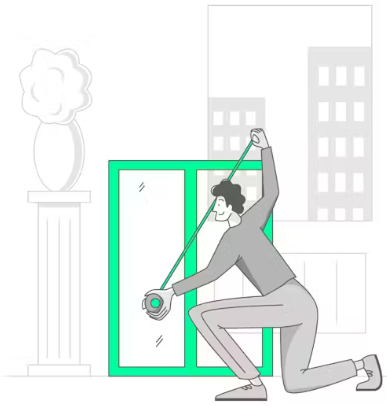
After installation, verifying the quality of the work is essential. Check for gaps, improper sealing, or difficulty in operation. Best Enterprises stands by their work, ensuring that every installation meets our high standards and your complete satisfaction.
Why Choose Best Enterprises General Contractor
Choosing Best Enterprises for window installation means benefiting from a unique combination of reliability, attention to detail, and customer-focused service. Their commitment to using high-quality materials and ensuring each installation is performed to the highest standards sets them apart.
Testimonials from satisfied customers often highlight the work’s professionalism, timeliness, and cleanliness, alongside the noticeable improvement in home energy efficiency and aesthetics. These endorsements testify to Best Enterprises’ dedication to exceeding customer expectations with every project undertaken.
Conclusion
Quality window installation is an investment in your home’s future. It’s about creating a more comfortable living environment, enhancing your home’s aesthetic appeal, and improving energy efficiency.
With Best Enterprises General Contractor, you’re installing windows and investing in your home’s future. Contact us today to see how we can transform your home with every pane installed to perfection.
Siding Upgrades: Boost Energy Efficiency and Cut Energy Bills
Every element counts in the quest for a more energy-efficient home — from the roof to the foundation and, notably, the siding. Siding does more than just beautify your home; it plays a pivotal role in regulating temperature and protecting against harsh elements. In today’s environmentally conscious world, understanding how siding upgrades can impact your energy bills is more crucial than ever.
Introduction
As homeowners seek sustainable living while managing costs, the significance of energy efficiency in homes has skyrocketed. Among the myriad strategies to enhance a home’s efficiency, siding upgrades have emerged as a particularly impactful approach. Siding is crucial in maintaining a home’s temperature and protecting it against the elements. This protective shell is instrumental in keeping the interior climate comfortable throughout the year, effectively reducing the need for excessive heating in the winter and cooling in the summer. As such, well-chosen and properly installed siding is about safeguarding the home from weather extremes and significantly contributing to energy savings and sustainability. By understanding and optimizing the performance of your home’s siding, you’re taking a crucial step towards a more energy-efficient, cost-effective, and environmentally friendly living environment.
The Importance of Siding for Energy Efficiency
Siding is the home’s first line of defense, crucial for protecting against the external environment and significantly influencing interior temperature control. This protective barrier is essential for insulation, effectively keeping warm or cool air inside, thereby lessening dependence on heating and cooling systems. Such efficiency assures a comfortable living environment and leads to notable energy savings. Choosing siding material and proper installation is key to maximizing these benefits, highlighting siding’s pivotal role in achieving a more energy-efficient home.
Types of Energy-Efficient Siding Materials
When it comes to siding, not all materials are created equal in terms of energy efficiency. Here’s a brief comparison:
- Vinyl Siding: Affordable and versatile, vinyl siding can be enhanced with insulated backing, significantly improving its thermal efficiency and contributing to energy savings.
- Fiber Cement Siding: Known for its durability and resistance to many forms of damage, fiber cement also offers moderate insulative properties. While not insulating as insulated vinyl, its robustness contributes to long-term energy efficiency.
- Insulated Siding: This category includes materials specifically designed to increase a home’s R-value, such as insulated vinyl siding. These materials offer superior thermal efficiency, directly contributing to substantial energy savings by improving the home’s ability to maintain stable internal temperatures.
Each material offers a different level of thermal efficiency, influencing your home’s energy consumption and costs. For instance, vinyl siding with insulated backing can significantly reduce heat transfer, making it an excellent choice for energy conservation. Fiber cement, while more focused on durability, still offers energy-saving benefits through its inherent insulating properties. With its high R-value, insulated siding is the best option for those prioritizing energy savings, as it directly addresses heat loss and gain.
Choosing the right siding material involves balancing thermal efficiency with other factors such as climate, aesthetic preferences, and budget. However, understanding the energy-saving potential of each option can guide homeowners to make informed decisions that align with their energy efficiency goals.
The Science Behind Energy Savings and Siding Upgrades
The advancement in siding materials and technology plays a significant role in enhancing a home’s energy efficiency. At the heart of this evolution is the scientific approach to improving insulation and air sealing, crucial aspects that directly impact energy savings.
- Improved Insulation: Modern siding materials are engineered with higher R-values, which indicate their insulation effectiveness. The higher the R-value, the better the material resists unwanted heat transfer. This means that heat stays inside the home during winter and outside in summer, reducing the need for heating and cooling systems to work overtime. Materials like insulated vinyl siding are specifically designed to provide this enhanced insulation, incorporating layers of rigid foam insulation that significantly reduce heat transfer.
- Advanced Air Sealing: Modern siding options offer improved air sealing capabilities and insulation. The design and installation techniques have evolved to minimize gaps and leaks where air can enter or escape from the home. This air sealing prevents wind-driven moisture infiltration and maintains controlled indoor air quality and temperature. Properly sealed siding systems reduce energy consumption by ensuring that heated or cooled air remains inside, making heating and cooling systems more efficient and less costly to operate.
This dual focus elevates the home’s thermal performance and supports environmental sustainability by reducing energy use. Opting for siding that integrates these technologies is smart for energy-conscious homeowners.
Real-Life Success Stories
Insulated vinyl siding has emerged as a standout choice for homeowners aiming to enhance their home’s energy efficiency. Such upgrades leverage advanced materials like Neopor® to significantly boost thermal efficiency, slashing energy costs and amplifying indoor comfort.
NEWPRO’s Energy Wall Siding Systems exemplify these benefits, offering up to 19% better R-value, which translates to noticeable energy savings and enhanced living comfort for homeowners. These real-life transformations underline the importance of selecting energy-efficient siding materials.
Visit NEWPRO and Allied Siding & Roofing to learn more about these impactful upgrades and read detailed success stories. These narratives highlight the difference the right siding choices can make in energy efficiency and home performance.
Choose the Right Siding for Your Home
Selecting the right siding involves considering the local climate, your home’s architectural style, and specific energy efficiency goals. It’s also crucial to ensure professional installation, as improper fitting can negate the benefits of high-quality siding materials, leading to potential energy losses.
Conclusion
Upgrading your home’s siding is an aesthetic improvement and a strategic investment toward lower energy bills and a smaller environmental footprint. Choosing the right materials and ensuring professional installation can significantly enhance your home’s energy efficiency.
Ready to transform your home with energy-efficient siding? Visit BestGC to schedule a consultation and explore your siding options. Our experts are dedicated to helping you make informed decisions that align with your energy-saving and home-improvement goals.
Choosing the Right Roofing Material for Your Climate
Selecting the ideal roofing material isn’t just about enhancing the aesthetic appeal of your home; it’s about ensuring maximum protection and energy efficiency tailored to your climate. From enduring scorching heat to braving icy chills and tropical downpours, your roof is your first defense against the elements. In this comprehensive guide, we’ll delve into the intricacies of climate-smart roofing and how to make the best choice for your home’s comfort and longevity.
Understanding Climate Considerations
Before diving into specific roofing materials, it’s essential to grasp how climate nuances impact their performance. Each climate presents unique roof challenges, from deserts’ blistering heat to polar regions’ icy chills. Here’s a breakdown of considerations for different climates:
- Hot Climates: Roofing materials in hot climates endure prolonged sun exposure and high temperatures. They must effectively reflect sunlight, dissipate heat, and resist UV radiation to prevent premature deterioration.
- Cold Climates: Harsh winters bring freezing temperatures, heavy snowfall, and freeze-thaw cycles that can cause damage. Roofing materials need to be resilient to frost, able to shed snow efficiently and prevent ice dams to avoid water infiltration.
- Tropical Climates: High humidity, intense sunlight, and occasional tropical storms characterize tropical regions. Roofs must withstand moisture, resist wind uplift, and maintain structural integrity during extreme weather events.
Roofing Materials Comparison
Let’s assess common roofing materials and their performance across different climates:
1. Asphalt Shingles:
- Hot Climates: Versatile but may degrade faster under intense sun.
- Cold Climates: Reasonable performance but susceptible to cracking.
- Considerations: Affordable and versatile, suitable for various climates.
2. Metal Roofing:
- Hot Climates: Reflects sunlight, ideal for reducing heat absorption.
- Cold Climates: Durable, prevents ice dams, and withstands cold weather.
- Considerations: Longevity and energy efficiency make it a solid choice for all climates.
3. Wood Shingles or Shakes:
- Hot Climates: May weather faster in intense sunlight.
- Cold Climates: Requires proper installation to prevent issues like rot.
- Considerations: Aesthetic appeal but demands regular maintenance.
4. Clay or Concrete Tiles:
- Hot Climates: Offers heat resistance and durability.
- Cold Climates: Withstands freezing temperatures but may crack under certain conditions.
- Considerations: Stylish and durable but requires adequate structural support.
5. Slate Roofing:
- Hot Climates: Natural thermal resistance makes it suitable.
- Cold Climates: Resilient to freeze-thaw cycles and performs well.
- Considerations: Elegant and long-lasting, albeit expensive.
Choosing the Right Roofing Material
Here are some key aspects to keep in mind when choosing the right roofing material for your specific climate:
- Ventilation: Ensure your roof has proper ventilation to avoid trapping moisture and heat.
- Insulation: Good insulation helps maintain consistent indoor temperatures and prevents problems like ice dams.
- Roof Pitch: The angle of your roof affects how effectively water and snow are shed.
Climate Roofing
Best Roof for Hot Climate:
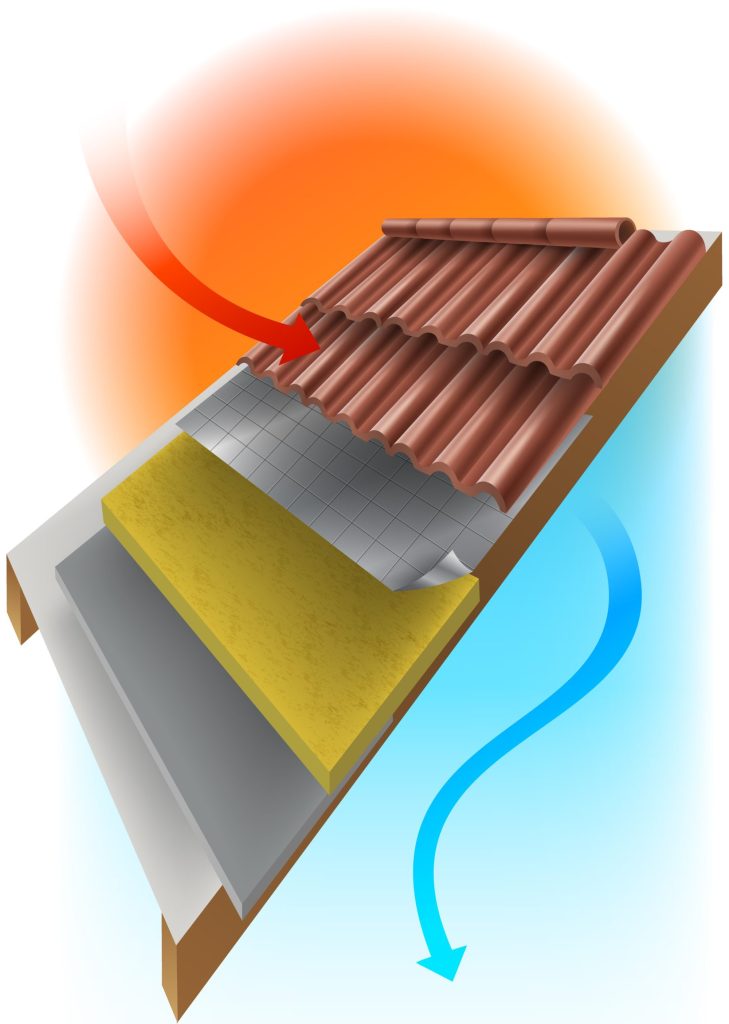
Reflective & Energy-Efficient – Metal roofing, light-colored asphalt shingles, or clay tiles are excellent choices for hot climates, as they can effectively reflect sunlight and dissipate heat, keeping your home cool and reducing energy costs.
Best Roof for Cold Climate:
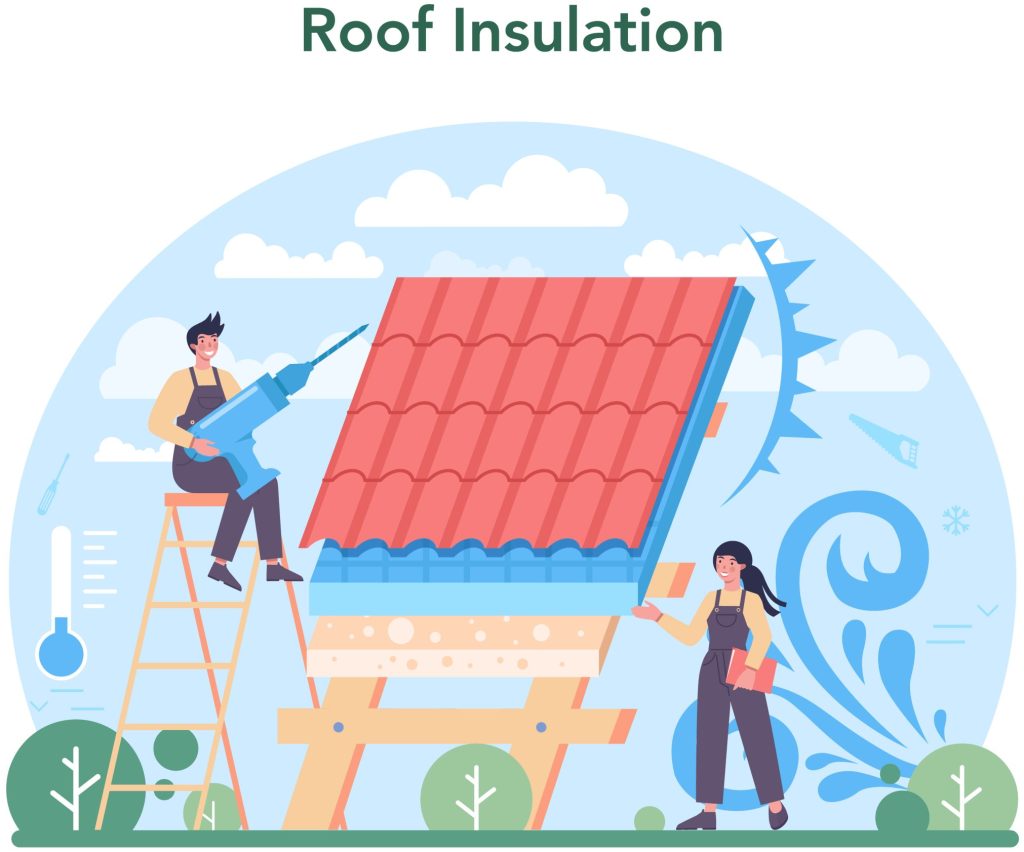
Insulation & Resistance: In cold climates, prioritize roofing materials that offer superior insulation and resistance to snow and ice buildup. Metal roofing, asphalt shingles with proper underlayment, or synthetic slate are ideal for protecting your home from harsh winter conditions.
Best Roof for Tropical Climate:
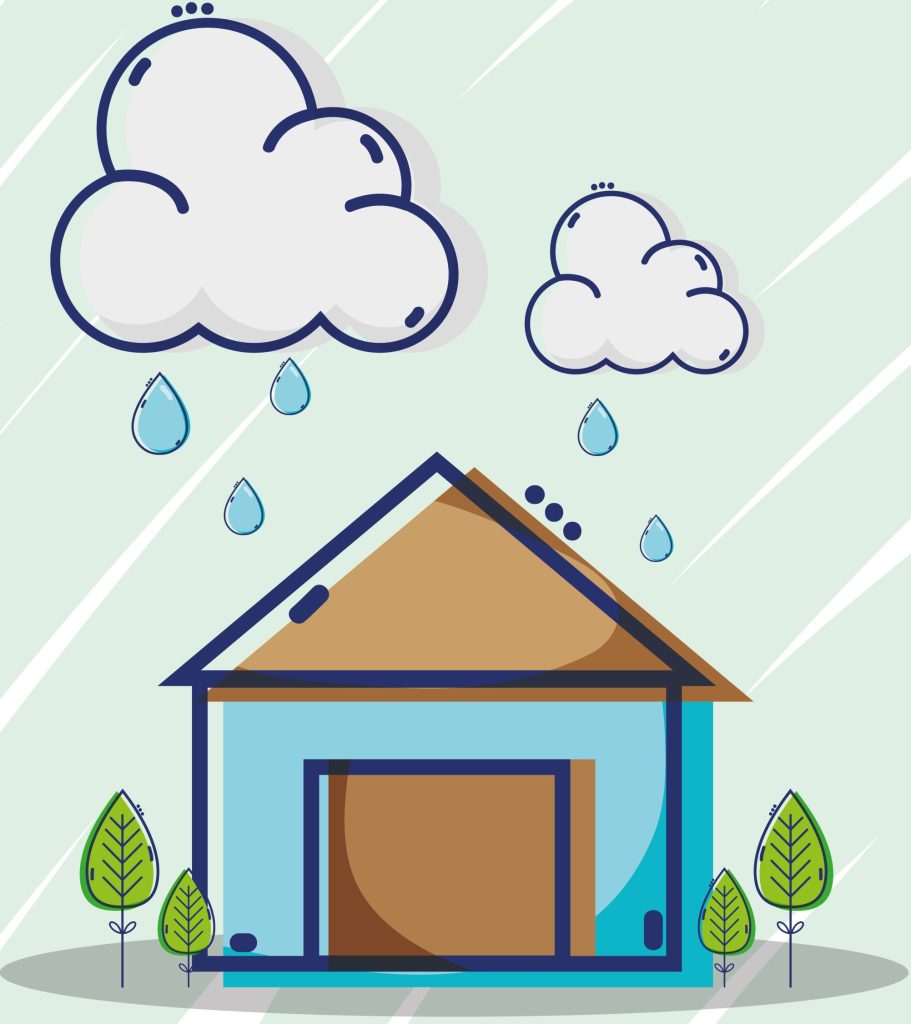
Moisture Resistance & Durability: Metal roofing, concrete tiles, or synthetic slate are ideal for tropical climates due to their resilience to high humidity and heavy rainfall. These materials offer durability and protection against the unique challenges of tropical weather conditions.
All-Climate Roofing:
- Versatility & Durability: Consider options like metal roofing and architectural shingles that perform well across various climates, offering versatility and durability to withstand diverse weather conditions.
- Investment Value: Investing in all-climate roofing solutions can provide long-term benefits and performance, offering peace of mind and protection against the elements for years to come.
Introducing Best Enterprises General Contracting
In East Northport, Best Enterprises General Contracting is a premier provider of expert roof installation services. Specializing in shingle roof installations, Best Enterprises GC offers diverse styles and colors to enhance your home’s curb appeal. With a dedication to blending aesthetics and functionality, our experts craft roofing solutions tailored to your needs. Beyond installation, Best Enterprises GC provides comprehensive services, incorporating top-tier materials, underlayment, ice and water shields, ridge vents, and premium accessories to ensure longevity and durability.
As affordable roofers, Best Enterprises GC makes high-quality installations accessible to homeowners. Our commitment to quality is underscored by a 50-year material warranty and a 10-year labor warranty, offering peace of mind and protection against unexpected expenses or repairs.
Conclusion
Investing in the right roofing material is a strategic decision encompassing aesthetics and functionality. By understanding your specific regional climate and consulting with roofing contractors like Best Enterprises GC, you can select a roof that enhances your home’s beauty and provides enduring protection against the elements. With careful consideration and expert guidance, you’ll ensure the longevity and resilience of your investment, securing peace of mind for years to come.
- Published in Blog, Remodeling, Roofing

